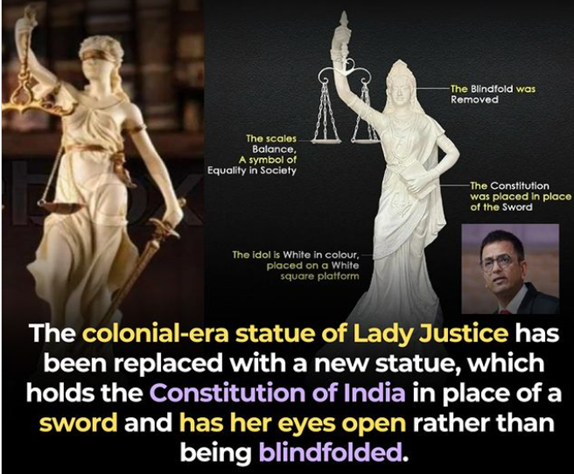- Courses
- GS Full Course 1 Year
- GS Full Course 2 Year
- GS Full Course 3 Year
- GS Full Course Till Selection
- Answer Alpha: Mains 2025 Mentorship
- MEP (Mains Enrichment Programme) Data, Facts
- Essay Target – 150+ Marks
- Online Program
- GS Recorded Course
- Polity
- Geography
- Economy
- Ancient, Medieval and Art & Culture AMAC
- Modern India, Post Independence & World History
- Environment
- Governance
- Science & Technology
- International Relations and Internal Security
- Disaster Management
- Ethics
- NCERT Current Affairs
- Indian Society and Social Issue
- NCERT- Science and Technology
- NCERT - Geography
- NCERT - Ancient History
- NCERT- World History
- NCERT Modern History
- NCERT Medieval History
- CSAT
- 5 LAYERED ARJUNA Mentorship
- Public Administration Optional
- ABOUT US
- OUR TOPPERS
- TEST SERIES
- FREE STUDY MATERIAL
- VIDEOS
- CONTACT US
Lady Justice is no longer blindfolded
Lady Justice is no longer blindfolded
22-10-2024

- On 18th Oct 2024, The Supreme Court of India revealed a new statue of Lady Justice that breaks from tradition.
- Unlike the old statue, which featured a blindfold and a sword, This new 6-foot-tall statue dressed in a saree and holding the scales in one hand and the Indian Constitution in the other.
- Chief Justice D.Y. Chandrachud said that it represents the idea that “law is not blind; it sees everyone equally.”
Changing Meaning of Lady Justice
-
Historical Roots:
- The image of Lady Justice can be traced back to Greek and Roman mythology.
- Themis: In Greek mythology, Themis is the goddess of justice, wisdom, and good counsel, often depicted with scales and a sword.
- Justitia: The first Roman emperor, Augustus, introduced the worship of Justitia, a goddess of justice, who also did not wear a blindfold.
-
The Blindfold Origin:
- The concept of a blindfolded Lady Justice appears to have originated from a woodcut published in 1494 by lawyer Sebastian Brant.
- This image, titled “The Fool Blindfolding Justice,” critiqued the idea of blind justice rather than celebrating it.
- By the early 17th century, the blindfold began to symbolize impartiality and was commonly associated with justice.
Lady Justice in India:
-
Colonial Influence:
- The British Raj introduced the iconography of Lady Justice to India, which continues to be a part of the country's legal system.
- The Calcutta High Court features carvings of Lady Justice, with some depictions blindfolded and others not.
- Similarly, the Bombay High Court has a statue of Lady Justice without a blindfold.
Major Changes to Lady Justice
- The blindfold is gone, symbolizing that the law is aware and does not ignore anyone.
- This change moves away from the old idea that justice should be blind.
-
Replacement of Sword:
- The sword has been replaced with the Indian Constitution, focusing on justice through laws rather than punishment.
- This highlights the importance of constitutional values in delivering justice.
- Cultural Adaptation: The statue now wears a saree, representing Indian culture, and is placed in the Supreme Court library.
- Retained Elements: The scales remain unchanged, symbolizing balance and fairness in justice.
Purpose of Changes:
- The changes aim to break free from British symbols, creating a unique Indian identity in the legal system.
- Emphasizing that the law is aware of everyone helps shift the focus from strict punishment to fairness.
- The new statue reflects current views on justice and the evolution of India’s legal system.
- The focus is now on the Constitution, showing that justice is based on legal principles.
- Incorporating Indian elements shows pride in the country's cultural identity.
Constitutional Values and Modern Indian Identity
- Justice is now based on the Constitution, promoting fairness and equality.
- The new statue supports creating a legal framework that is distinctly Indian.
- Justice should be aware and fair, encouraging transparency in legal decisions.
- Emphasizes equal treatment and fairness in legal proceedings, blending modern and Indian values.
Conclusion:
The new Lady Justice statue represents a shift in India's legal symbols, moving away from colonial influences toward a representation that values fairness and equality. By replacing traditional symbols with those reflecting constitutional principles, India is modernizing its legal identity while honoring its unique culture.
Must Check: Best IAS Coaching In Delhi
UPSC Prelims Result 2024 Out: Expected Cut Off & Other Details, UPSC Prelims 2024 Answer with Explanation, Daily Prelims Quiz, Daily Current Affairs, MONTHLY CURRENT AFFAIRS TOTAL (CAT) MAGAZINE, Best IAS Coaching Institute in Karol Bagh, Best IAS Coaching Institute in Delhi, Daily Mains Question Answer Practice, ENSURE IAS UPSC Toppers, UPSC Toppers Marksheet, Previous Year Interview Questions, UPSC Syllabus




